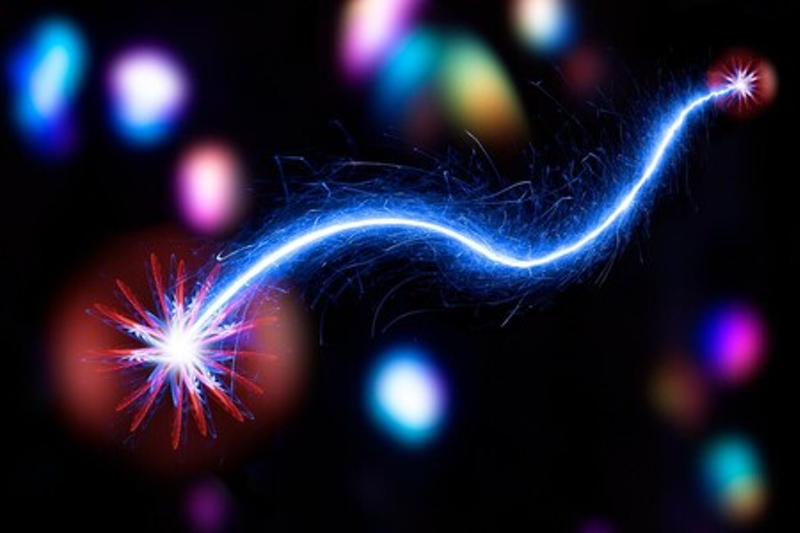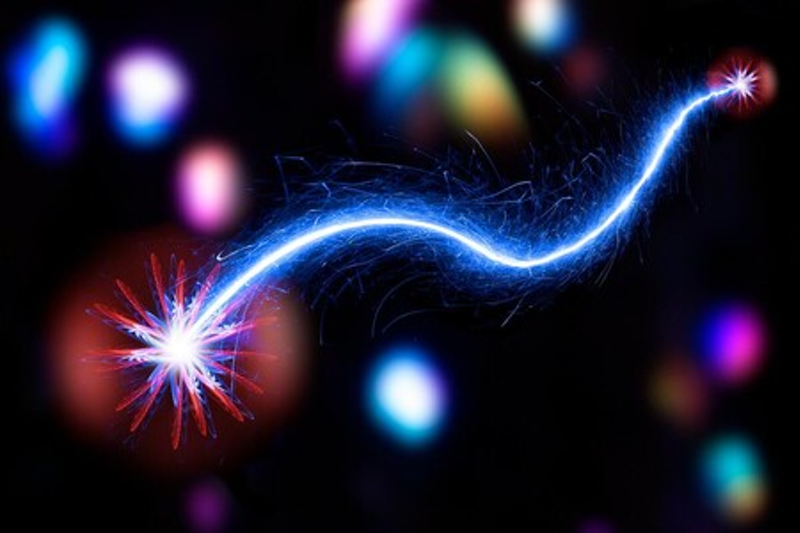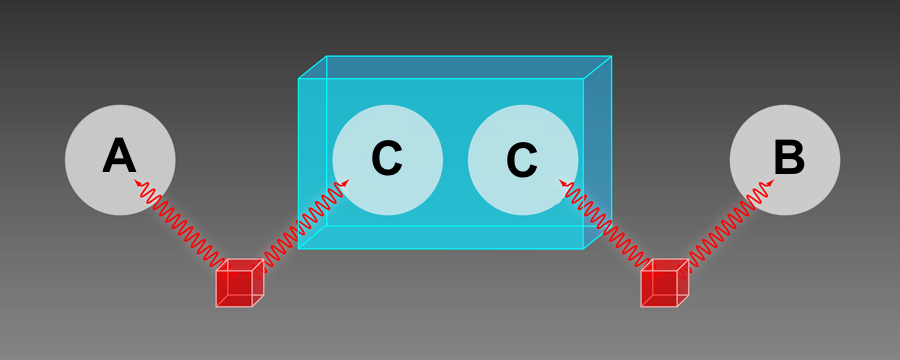Nobel Prize: Quantum Entanglement Unveiled
7 October 2022: We have replaced our initial one-paragraph announcement with a full-length Focus story.
The Nobel Prize in Physics this year recognizes efforts to take quantum weirdness out of philosophy discussions and to place it on experimental display for all to see. The award is shared by Alain Aspect, John Clauser, and Anton Zeilinger, all of whom showed a mastery of entanglement—a quantum relationship between two particles that can exist over long distances. Using entangled photons, Clauser and Aspect performed some of the first “Bell tests,” which confirmed quantum mechanics predictions while putting to bed certain alternative theories based on classical physics. Zeilinger used some of those Bell-test techniques to demonstrate entanglement control methods that can be applied to quantum computing, quantum cryptography, and other quantum information technologies.
Since its inception, quantum mechanics has been wildly successful at predicting the outcomes of experiments. But the theory assumes that some properties of a particle are inherently uncertain—a fact that bothered many physicists, including Albert Einstein. He and his colleagues expressed their concern in a paradox they described in 1935 [1]: Imagine creating two quantum mechanically entangled particles and distributing them between two separated researchers, characters later named Alice and Bob. If Alice measures her particle, then she learns something about Bob’s particle—as if her measurement instantaneously changed the uncertainty about the state of his particle. To avoid such “spooky action at a distance,” Einstein proposed that lying underneath the quantum framework is a set of classical “hidden variables” that determine precisely how a particle will behave, rather than providing only probabilities.
The hidden variables were unmeasurable—by definition—so most physicists deemed their existence to be a philosophical issue, not an experimental one. That changed in 1964 when John Bell of the University of Wisconsin-Madison, proposed a thought experiment that could directly test the hidden variable hypothesis [2]. As in Einstein’s paradox, Alice and Bob are each sent one particle of an entangled pair. This time, however, the two researchers measure their respective particles in different ways and compare their results. Bell showed that if hidden variables exist, the experimental results would obey a mathematical inequality. However, if quantum mechanics was correct, the inequality would be violated.
Bell’s work showed how to settle the debate between quantum and classical views, but his proposed experiment assumed detector capabilities that weren’t feasible. A revised version using photons and polarizers was proposed in 1969 by Clauser, then at Columbia University, along with his colleagues [3]. Three years later, Clauser and Stuart Freedman (both at the University of California, Berkeley) succeeded in performing that experiment [4].
The Freedman-Clauser experiment used entangled photons obtained by exciting calcium atoms. When a calcium atom de-excites, it can emit two photons whose polarizations are aligned. The researchers installed two detectors (Alice and Bob) on opposite sides of the calcium source and measured the rate of coincidences—two photons hitting the detectors simultaneously. Each detector was equipped with a polarizer that could be rotated to an arbitrary orientation.
Freedman and Clauser showed theoretically that quantum mechanics predictions diverge strongly from hidden variable predictions when Alice and Bob’s polarizers are offset from each other by 22.5° or 67.5°. The researchers collected 200 hours of data and found that the coincidence rates violated a revamped Bell’s inequality, proving that quantum mechanics is right.
The results of the first Bell test were a blow to hidden variables, but there were “loopholes” that hidden-variable supporters could claim to rescue their theory. One of the most significant loopholes was based on the idea that the setting of Alice’s polarizer could have some influence on Bob’s polarizer or on the photons that are created at the source. Such effects could allow the elements of a hidden-variable system to “conspire” together to produce measurement outcomes that mimic quantum mechanics.
To close this so-called locality loophole, Aspect and his colleagues at the Institute of Optics Graduate School in France performed an updated Bell test in 1982, using an innovative method for randomly changing the polarizer orientations [5]. The system worked like a railroad switch, rapidly diverting photons between two separate “tracks,” each with a different polarizer. The changes were made as the photons were traveling from the source to the detectors, so there was not enough time for coordination between supposed hidden variables.
Zeilinger, who is now at the University of Vienna, has also worked on removing loopholes from Bell tests (see Viewpoint: Closing the Door on Einstein and Bohr’s Quantum Debate, written by Aspect). In 2017, for example, he and his collaborators devised a way to use light from distant stars as a random input for setting polarizer orientations (see Synopsis: Cosmic Test of Quantum Mechanics).
Zeilinger also used the techniques of entanglement control to explore practical applications, such as quantum teleportation and entanglement swapping. For the latter, he and his team showed in 1998 that they could create entanglement between two photons that were never in contact [6]. In this experiment, two sets of entangled photon pairs are generated at two separate locations. One from each pair is sent to Alice and Bob, while the other two photons are sent to a third person, Cecilia. Cecilia performs a Bell-like test on her two photons, and when she records a particular result, Alice’s photon winds up being entangled with Bob's. This swapping could be used to send entanglement over longer distances than is currently possible with optical fibers (see Research News: The Key Device Needed for a Quantum Internet).
“Quantum entanglement is not questioned anymore,” says quantum physicist Jean Dalibard from the College of France. “It has become a tool, in particular in the emerging field of quantum information processing, and the three nominated scientists can be considered as the godfathers of this new domain.”
Quantum information specialist Jian-Wei Pan of the University of Science and Technology of China in Hefei says the winners are fully deserving of the prize. He has worked with Zeilinger on several projects, including a quantum-based satellite link (see Focus: Intercontinental, Quantum-Encrypted Messaging and Video). “Now, in China, we are putting a lot of effort into actually turning these dreams into reality, hoping to make the quantum technologies practically useful for our society.”
–Michael Schirber
Michael Schirber is a Corresponding Editor for Physics Magazine based in Lyon, France.
References
- A. Einstein et al., “Can quantum-mechanical description of physical reality be considered complete?” Phys. Rev. 47, 777 (1935).
- J. S. Bell, “On the Einstein Podolsky Rosen paradox,” Physics 1, 195 (1964).
- J. F. Clauser et al., “Proposed experiment to test local hidden-variable theories,” Phys. Rev. Lett. 23, 880 (1969).
- S. J. Freedman and J. F. Clauser, “Experimental test of local hidden-variable theories,” Phys. Rev. Lett. 28, 938 (1972).
- A. Aspect et al., “Experimental test of Bell’s inequalities using time-varying analyzers,” Phys. Rev. Lett. 49, 1804 (1982).
- J. W. Pan et al., “Experimental entanglement swapping: Entangling photons that never interacted,” Phys. Rev. Lett. 80, 3891 (1998).






